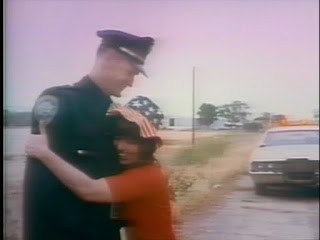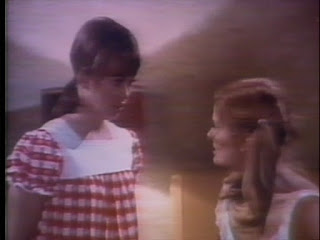Ah, the Bechdel test. No doubt it's a crude metric, and it's often overlooked that the comic strip character who first gave voice to it also refused to see any movies that didn't pass it -- a stance that, to use the term so in vogue these days, is a bit "problematic".
Still, it's an interesting yardstick by which to measure these two films. In the first, there are literally no women at all (though household appliances complicate the picture a bit), so it doesn't so much fail the Bechdel test as decline to even show up for the exam.
Meanwhile, we have a second, female-dominated film that -- but for the presence of a handful of men -- would have been a single-sex affair too. The ladies in this movie have plenty of conversations about things other than guys, but whether it should be seen as an exemplar of feminist values is, perhaps, best left as an exercise for the reader.
Still, it's an interesting yardstick by which to measure these two films. In the first, there are literally no women at all (though household appliances complicate the picture a bit), so it doesn't so much fail the Bechdel test as decline to even show up for the exam.
Meanwhile, we have a second, female-dominated film that -- but for the presence of a handful of men -- would have been a single-sex affair too. The ladies in this movie have plenty of conversations about things other than guys, but whether it should be seen as an exemplar of feminist values is, perhaps, best left as an exercise for the reader.
Grade: C-
Ah, the legend of the Flying Dutchman: subject of many a tale told in seedy taverns by salt-speckled sailors, as well as multiple operas (most famously Wagner's), movies, and even episodes of Spongebob.
It's a well-worn yarn, and A Passenger to Bali is a well-traveled adaptation that ditches the story's supernatural elements in favor of a more philosophical approach. It's been produced as a radio play, published in print by Little, Brown & Co., and even seen on Broadway -- though that production was a box office disaster that lasted all of four performances.
And now it's been recycled into an episode for the TV show Studio One in Hollywood -- so yes, we're dealing with television here, for good or ill. And as you might expect from an early TV production (let alone one adapted from a play), A Passenger to Bali is a fairly stagy affair, with no real ambitions to go beyond the parameters of conventional theater.
Watching an effort like this underscores two things: first, that our modern sense of The Twilight Zone as a wild anomaly is clearly incorrect, as Serling's anthology series had plenty of precedents on the small screen; and second, that in general The Twilight Zone still did this sort of thing a lot better than its predecessors or contemporaries.
That's not to say A Passenger to Bali is bad, as it certainly isn't. But if it has any aspirations toward excellence, the limits of its dramatic conception -- and its failure to take full advantage of the new medium -- stand in its way.
The main cast could best be described as "workmanlike". That's not meant pejoratively at all, as they all turn in professional but unremarkable performances -- and after all, sometimes being unremarkable is doing the job right.
All the better, then, to turn the spotlight on Berry Kroeger as the mysterious Mr. Walkes, a traveler who convinces the aptly-named Captain English (Colin Keith-Johnston) to grant him last-minute passage against the captain's better judgment.
Kroeger worked with Orson Welles, to whom several writers have compared his grandiose performance here -- though to our mind, it's more "Donald Sutherland channeling Kelsey Grammer channeling Orson Welles". Either way, Kroeger does his best to overcome the script's lack of momentum with sheer presence. He preens, struts, chews the scenery now and then, and encourages the camera to linger on his leering, overripe face.
Oh, and he gets in some light reading too. (We expected a Commie, but he's into something a bit more outré.)
Now, the funny wildcard in Mill Creek's presentation of A Passenger to Bali is its inclusion of vintage commercials -- whether from the original broadcast or a later one, we don't know. But twice during the feature, and once at its end, we're interrupted so that Betty Furness can try to sell us an entertainment center:
Or a refrigerator -- with the aid of a Mad Lib, whose blank a modern woman might buzz in to fill with a rather different answer:
And finally, burn-proof plastic countertops:
Among the people involved in A Passenger to Bali's production, perhaps it troubled the nobler souls to know its narrative -- and vague, noncommittal political critique -- would be subject to the repeated intrusions of unabashed consumerism. "Maybe it'll be better in 60-70 years," they thought, "and by then we won't have commercial interests meddling with our work."
If only they knew!
Grade: C+
"Nuns or sorority girls?"
Upon hearing the title of Sisters of Death, did some nameless producer ask this natural question? If so it might have inspired the film's opening sequence, in which veiled women deliver ritualistic utterances in a unison monotone. Are we seeing the operation of a specifically religious cult, or just the kind that treats minorities badly during spring break in Cabo?
Naah, it's just the "Woo, party!" kind of sisters. And boy, do they have one hell of a hazing ritual!
So when something goes very wrong -- and it's telegraphed from the beginning that it will --
-- the question isn't whether someone will take revenge, but who that will be. Sure, it takes a while:
But ultimately, when a set of ominous-looking handwritten invitations arrive in the mail, it's clear the first gong of a very long game has been struck for these five young ladies.
Some of them have grave misgivings about going to this "seven-year reunion" (who has a 7-year reunion?), but reluctantly decide to come anyway.
Others are willing to hitchhike long distances to get there, even if it means accepting rides from sketchy Saddam-looking Mexican dudes with wandering hands.
And some are so excited that they speed and get pulled over by a cop straight out of Adam-12 (real-life policeman Vern Mathison, who's a trip to see).
In the end, all five converge in a parking lot in Paso Robles, CA, where two enterprising young men are tasked with the charge of delivering them to their destination. Transporting this vanload of attractive young women is a paying gig, but one gets the sense they might've done it for free.
All aboard for fun time? At first it seems that way, but it doesn't take long before doubt creeps in for even the most upbeat members of our party, as it dawns on them how seldom "I've brought you all here together" works out well for those brought.
True, a nice spread awaits them upon their arrival to the isolated estate where the reunion is to be held. (Who holds a reunion for five people?)
But signs indicate that out of this Hotel California, it may not be so easy to check. And that is something up with which they shall not put.
Soon enough, the good times have clearly come to an end, as "Woo, party!" inevitably gives way to "Ohmigod!" -- albeit an "Ohmigod" that apparently doesn't preclude solo showers, lone-wolf excursions, or other complete failures to employ meaningful survival strategies.
In fairness Sisters of Death is a bit older than it appears, as it sat on the shelf for several years before release, and slasher-movies tropes that were predictable in 1976 were marginally less so in 1972. But even contemporary characters in horror films would be hard pressed to anticipate the onslaught of...the art connoisseur of death!
Or the artisanal bullet maker (heh, "maker") of death!
Or -- most dangerous and unexpected of all -- the flautist of death!
Anyway, Sisters of Death (of death!) plays out on the slow side, but otherwise is an amusing little goof of a film in a well-established tradition. Naturally, it helps to have an appreciation for the aesthetics of the early 1970s, whether musical, textile, or feminine -- though the low-quality transfer employed here doesn't really do justice to any of that.
Also, full disclosure, the distaff side of our duo enjoyed it more than the spear side -- but both of us had our attention funneled well enough for its 87 minutes.
And that's about all we have to say on this one, so: play us off, Keyboard Cop!


















































